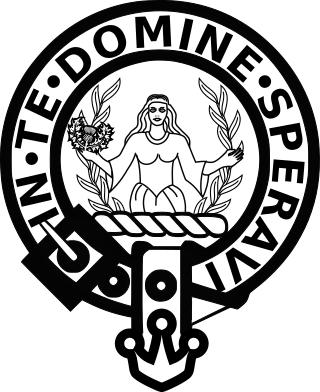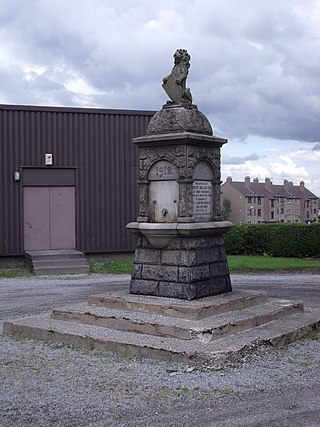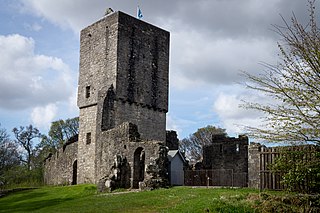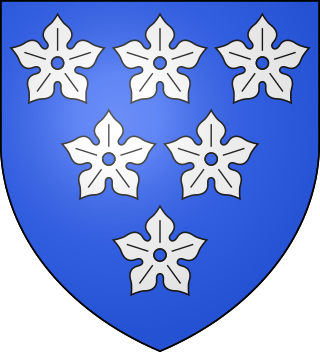
The Falls of Clyde is the collective name of three linn on the River Clyde near New Lanark, South Lanarkshire, Scotland. The Falls of Clyde comprise the upper falls of Bonnington Linn, Corra Linn, and Dundaff Linn. Corra Linn is the highest, with a fall of 26 metres (84 ft). Bonnington Linn, and Dundaff Linn are above New Lanark and located within the Falls of Clyde Reserve managed by the Scottish Wildlife Trust, a national nature conservation charity. Stonebyres Linn is located several miles downstream from the reserve and New Lanark.

Clan Lyon is a Scottish clan.

Clan Graham has two main families of Scottish clans, the Grahams of Menteith and the Grahams of Montrose. Each have their own tartan patterns. William Graham became the 7th Earl of Menteith in 1610 in what is now Perthshire, Scotland. The Grahams of Montrose had territories in both the Scottish Highlands and Lowlands, and the chief of the clan rose to become the Marquess and later Duke of Montrose.

Sir John de Graham of Dundaff was a 13th-century Scottish noble. He was killed during the Battle of Falkirk.

Clan Crichton is a Lowland Scottish clan that historically ruled Dumfries.

Clan Ogilvy, also known as Clan Ogilvie, is a Highland Scottish clan. Originating from Angus, Scotland, the progenitor of the Clan received a barony from King William the Lion in 1163. In 1491, King James IV elevated Sir James Ogilvy as Lord Ogilvy of Airlie.

Mugdock Castle was the stronghold of the Clan Graham from the middle of the 13th century. Its ruins are located in Mugdock Country Park, just west of the village of Mugdock in the parish of Strathblane. The castle is within the registration county of Stirlingshire, although it is only 2 kilometres (1.2 mi) north of Milngavie, East Dunbartonshire, on the northern outskirts of Greater Glasgow.

David Stewart, Prince of Scotland, was a 14th-century Scottish magnate. He was the eldest son of the second marriage of King Robert II with Euphemia de Ross. King Robert, on 26 March 1371, the day of his coronation, created him Earl of Strathearn, and on the following day his son David performed homage to his father as of Earl of Strathearn.
Euphemia Stewart, Countess of Strathearn was a medieval Scottish noblewoman, the daughter of David Stewart, Earl Palatine of Strathearn and Caithness. She succeeded to both her father's titles after his death between 1385 and 1389, probably March 1386.

Alexander Fraser of Touchfraser and Cowie was a member of the Scottish nobility who served as the Lord Chamberlain of Scotland and also as the Sheriff of Stirling and Sheriff of Kincardine. He was a descendant of the Clan Fraser members deriving from Oliver Castle. Alexander died at the Battle of Dupplin Moor.
Herbertshire Castle was a castle built in the Barony of Herbertshire in the early fifteenth century, located near Dunipace, Falkirk, central Scotland. It is said once to have been a royal hunting station. Its situation on elevated ground on the north bank of the River Carron, Forth was “very beautiful”. It was in an L-plan, dominated by a four-storey, rectangular, battlemented tower. In 1889 it was described as a large and lofty structure, measuring 63'6" in length, including the wing, by 43'8" in breadth. The small limb forming the L was 26'2" wide and appears to have projected about 12'. It formed a landmark for miles around. It was badly damaged in a fatal fire in 1914 which claimed three lives, and lay in ruins until its demolition in the 1950s. The grounds remain, as Herbertshire Castle Park, also known as Denny Gala Park. Nothing remains of the castle but an area of low scarps and shallow depressions.

Dunduff Castle is a restored stair-tower in South Ayrshire, Scotland, built on the hillside of Brown Carrick Hills above the Drumbane Burn, and overlooking the sea above the village of Dunure.

Stobo Castle is located at Stobo in the Scottish Borders, in the former county of Peeblesshire. The Manor of Stobo was originally owned by the Balfour family. It became the family seat of the Graham-Montgomery Baronets from 1767. The building of the present castle began in 1805 and was completed in 1811 under the supervision of architects Archibald and James Elliot. It is currently operated as a health spa. The house is protected as a category A listed building, while the grounds are included in the Inventory of Gardens and Designed Landscapes in Scotland, the national listing of significant parks and gardens.
Patrick Lyon, 1st Lord Glamis P.C. was a Scottish nobleman, created Lord Glamis on 28 June 1445.

Ochiltree Castle was a castle built on a promontory by the Lugar Water, East Ayrshire, Scotland across from Auchinleck Castle. Built by the de Colville family in the 12th century, it was destroyed in 1449, by Sir William Douglas.
The Barony of Grougar is a Scottish feudal barony which lies in north Ayrshire in the district formerly known as Cunninghame. The earliest known family likely to have owned Grougar were the De Morvilles who were there in the twelfth and thirteenth centuries before the reign of Robert the Bruce. The De Morvilles originated in Morville, Department of Manche, Normandy, arrived in England in the wake of the Norman Conquest, settled in Burg, Cumbria, and later moved to Scotland in the early 12th century where they were granted land in Ayrshire. This land grant precedes the establishment of the Register of the Great Seal of Scotland so cannot be positively confirmed. Hugo de Morville who died in 1202 was the Constable of Scotland. By the late thirteenth century the Logan family were barons of Grougar. Thorbrand de Logan baron of Grougar is recorded in 1272 and a John de Logan of Grugar may be the John Logan described as ‘one of the king of England's enemies’ in 1307 during the Wars of Independence.

The Barony of Stobo is a Scottish feudal barony which takes its name from Stobo in the Scottish Borders.

Sir Patrick de Graham, Lord of Kincardine was a 13th-century Scottish noble and soldier.
Sir David de Graham of Dundaff was a 13th-century Scottish noble.

John Stewart of Ralston was a 14th—century Scottish noble. He was a son of Walter Stewart, 6th High Steward of Scotland and Isabel Graham. He was the half brother of King Robert II of Scotland.














